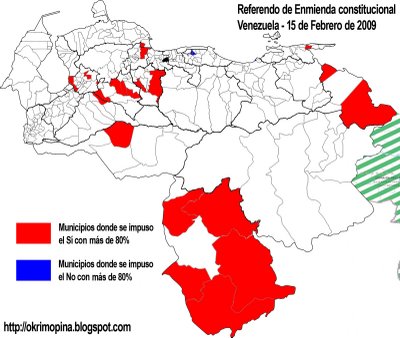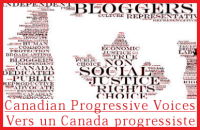Popular Venezuelan bloguero Okrim Al Qasal has some interesting insights for us into how last week’s referendum to remove term limits from the Venezuelan constitution went. Let’s follow his bouncing ball (with segments in bold type and indent translated by Your Humble One):
You’ve already seen that red and blue map I posted, so I won’t repeat it here.Okrim provides us with another map, one showing in which municipalities the vote was 50-60% (yes in red, no in blue):Of Venezuela’s 335 municipalities, the Yes vote took 281, while the No carried 54. Or in other words, in 83.88% of Venezuelan municipalities they voted to remove all term limits, including that of the President of the Republic.
 …and writes:
…and writes:
Now, here’s another map, this one showing where the respective votes carried by 60-70%:90 municipalities that voted Yes were within this margin, and 41 which voted No. Compared with the 281-54 at the national level, in this range the relation is more even. We will see that this near-equilibrium will not repeat itself in larger margins.
 As you can see, there’s a lot more red than blue there! Hmm, whatever could it mean? Tell us, Okrim:
As you can see, there’s a lot more red than blue there! Hmm, whatever could it mean? Tell us, Okrim:
And if you think that’s impressive, wait’ll you see the next map:Only seven municipalities voted for No by 60-70% of the vote, against 97 who voted Yes in this same margin!
 This is the map showing where the respective votes carried by 70-80%. Writes Okrim:
This is the map showing where the respective votes carried by 70-80%. Writes Okrim:
And finally, here’s where the vote went more than 80%.In this margin, the No vote won in only two municipalities, while the Yes took 72!
 Take it away, Okrim:
Take it away, Okrim:
No shit, Sherlock. One of the things that made me chuckle at a leading oppo site (no, I won’t link it, they get enough English-speaking traffic already–too much, in fact) is that they used a map that completely distorted the shape of the country to make their “point” that the vote was close. (It wasn’t–a 10% spread is pretty damn convincing, unless you, like the oppos, happen to be pretty damn dissociated.) But it doesn’t matter which way they slice it–where Venezuela went red, it typically went very very red, while the spots that went blue, overwhelmingly went a rather pale blue, with only a few small dark hotspots. Refer again to the maps I posted earlier on, they don’t lie.Okrim points out that the oppos like to concentrate their efforts in high-population areas where they are likely to have a greater success; they never even show up to campaign in the sparsely populated “outback” regions such as Apure, Delta Amacuro, etc., where the population has long been neglected by the traditional ruling classes anyway (being as it’s predominantly campesino, indigenous, non-white, etc. In other words, not what they call your “quality” folks.) How to counteract this urban oppo vote-suck? Okrim recommends three things:For collectors of curiosities, note that the reddest municipality in Venezuela, in this referendum, has been Antonio Díaz in Delta Amacuro (97.67% Yes), and the most oppositionist is El Hatillo in Miranda (83.14% No). As we have seen in these maps, the overwhelming majority of the victory was for the Yes side, while the No obtained much more modest ones. That is, of the 281 municipalities that went to the Yes, in 191 it was incontestible, with more than 60% of the vote. Meanwhile, of the 54 that went to No, only 13 achieved a margin greater than 60%.Or in other words, in 68% of the Yes municipalities, the vote was more than 60%, while in the No municipalities, only 24% carried with more than 60%. Of the 335 municipalities in Venezuela, 57% voted clearly for Yes, while barely 4% voted as clearly for No. The rest–39%–went for one or the other option more timidly.How, with such geographically-linked results, could the final vote toll be much more adjusted–in round numbers 55% Yes, 45% No?If we looked at the extremes, for example, we’d see that Antonio Díaz (Delta Amacuro), with 97% Yes, that is 15,992 votes, while El Hatillo (Miranda), with 83% No, that is 28,657 votes–practically double the number. This relation can also be seen in other locations. For example, barely four municipalities reached 80% for No, but these were Chacao, Baruta, El Hatillo (Miranda) and Diego Bautista Urbaneja (Anzoátegui). They add up to 218,391 votes. The 22 muncipalities which reached or surpassed 80% Yes added up to 136,776 votes. That is, the 4 municipalities which voted overwhelmingly for No surpassed the 22 that voted overwhelmingly for Yes, by 90,000 votes. The key, in other words, is the population of each municipality.
That last one is interesting, no? The oligarchs have successfully gotten the middle classes on their side, and have even made inroads in the barrios, by making out in the media that the opposition are being oppressed by the Revolution (despite an overwhelming preponderance of evidence to the contrary.) It’s sad to see how easily those people have been manipulated, and I’m sure a large amount of the No vote is due precisely to that.BTW, the comments section on this article at RadioMundial is small as yet, but very interesting, too. Writes “Alejandro Bermúdez”, from Barquisimeto:a) Bolster support with more aid in the interior, where campesino support is one of the principal motors of the Bolivarian process–and where 213 campesino activists have been killed in the last ten years. b) Deal with extreme urgency with problems in the urban areas–mainly violent crime, housing shortages, transportation and sanitation, so that the far-right cannot keep winning in barrios and populous neighborhoods. Reactionary sectors have taken advantage of these problems without any scruples whatsoever.c) Avoid antagonizing sectors of the opposition with inflammatory language. Fidel Castro said it in 2004: there aren’t 4 million oligarchs in Venezuela, and there shouldn’t be five.
I don’t have confirmation (YET) of any of this, but it wouldn’t surprise me if it were true. The opposition has a huge bag of dirty tricks; the Colombian paras and the major media are all in it and have been from the outset. And remember: They still get funding from Washington, too. Keep watching this space, kids, the next few months could shake out a lot of interesting cockroaches from the underside of the oppos.In the meantime, a ten-point margin of victory is still nothing to sneeze at. Even if the oppos cheated and got away with it, they still lost. The Bolivarian process, in other words, is strong enough to survive whatever they throw at it.What’s missing in this analysis is that in the 2409 electoral centres, which Súmate denounced on Televen for having indelible ink that wasn’t, are precisely where the No side won, and now they’re lying about it.In Barquisimeto, in my polling station and in the others around it, they won and the ink wasn’t indelible–they switched it. I denounced them and nobody stopped them from doing it.Something needs to be done in Táchira, Mérida and Zulia, because the (Colombian) paramilitaries vote in and dominate these zones so that they go against the central government.< /strong>



